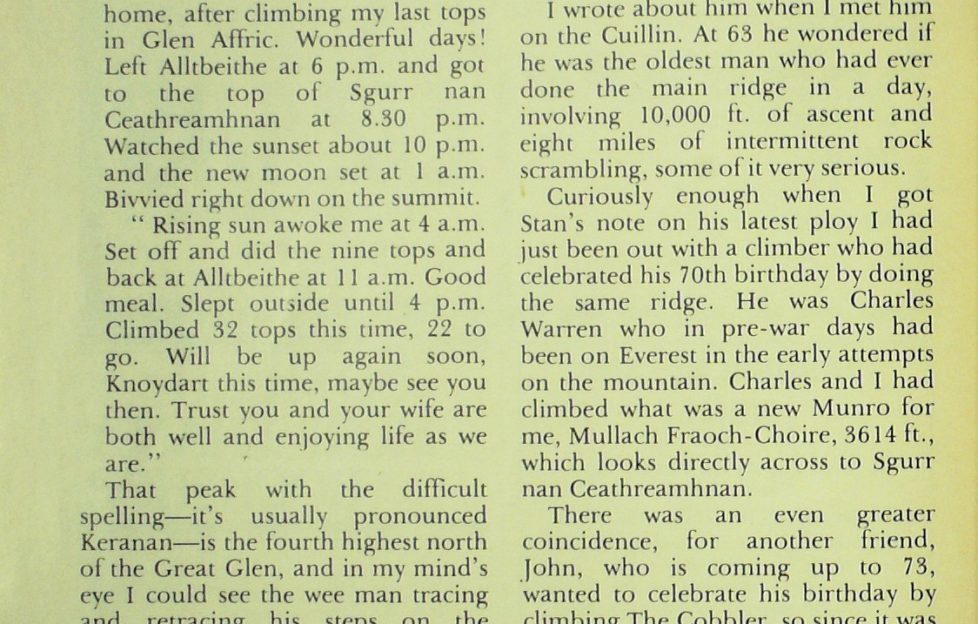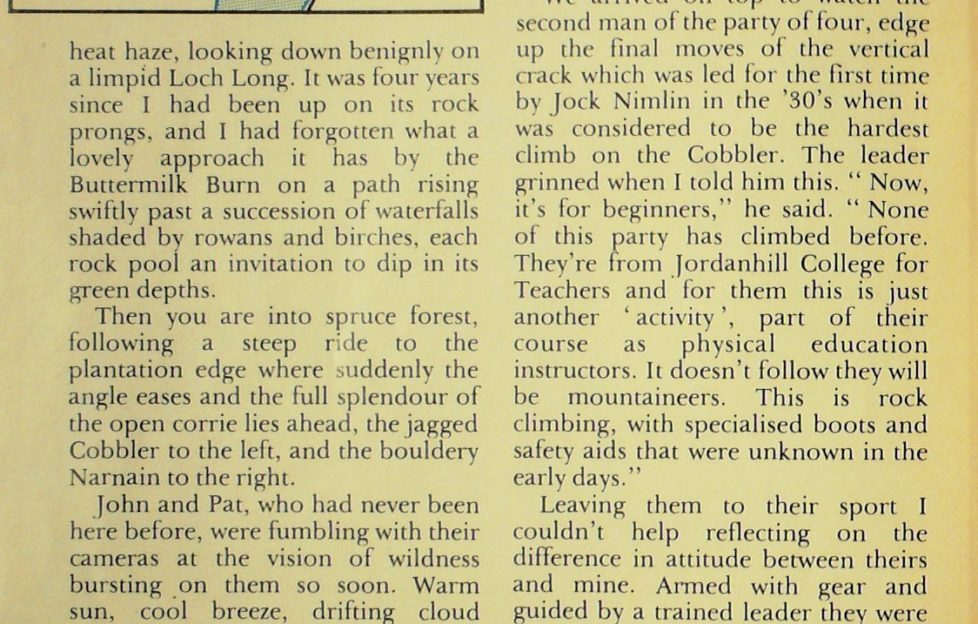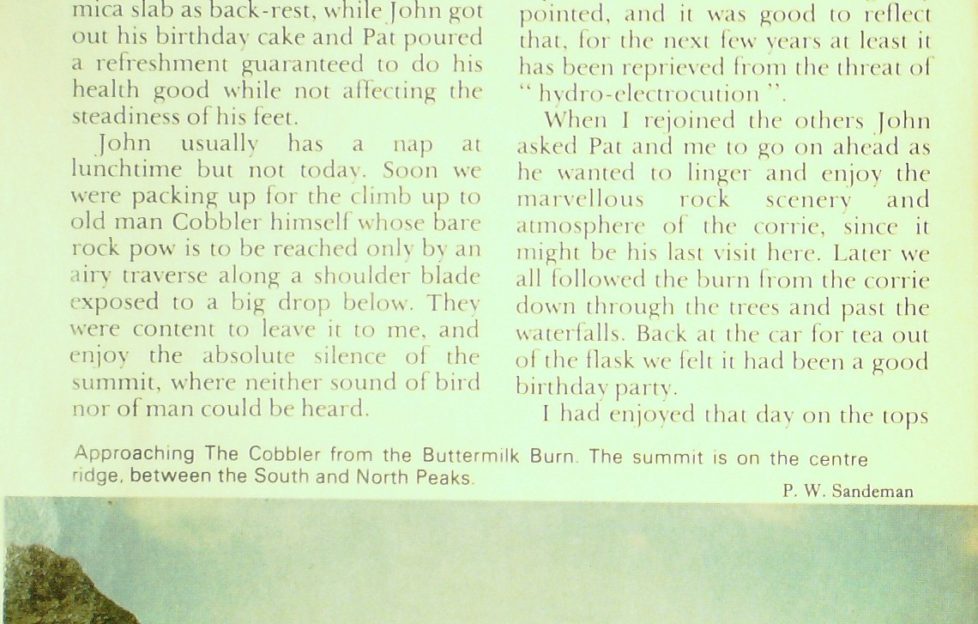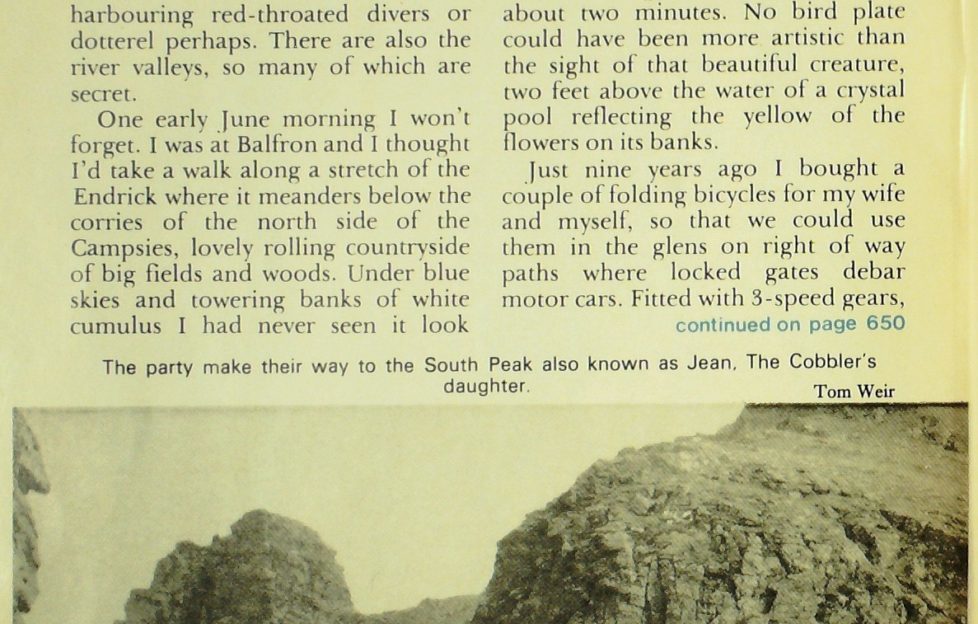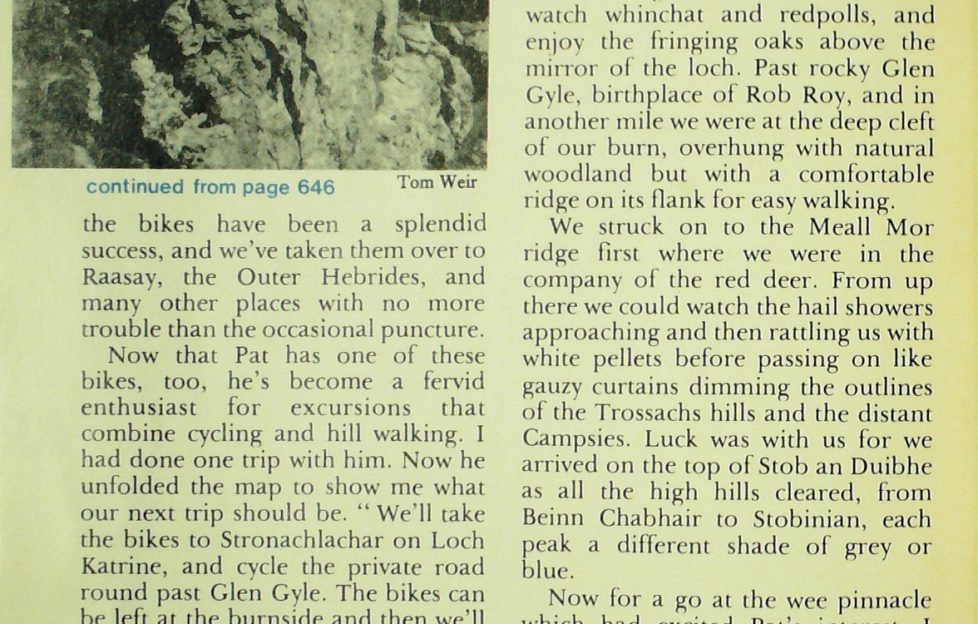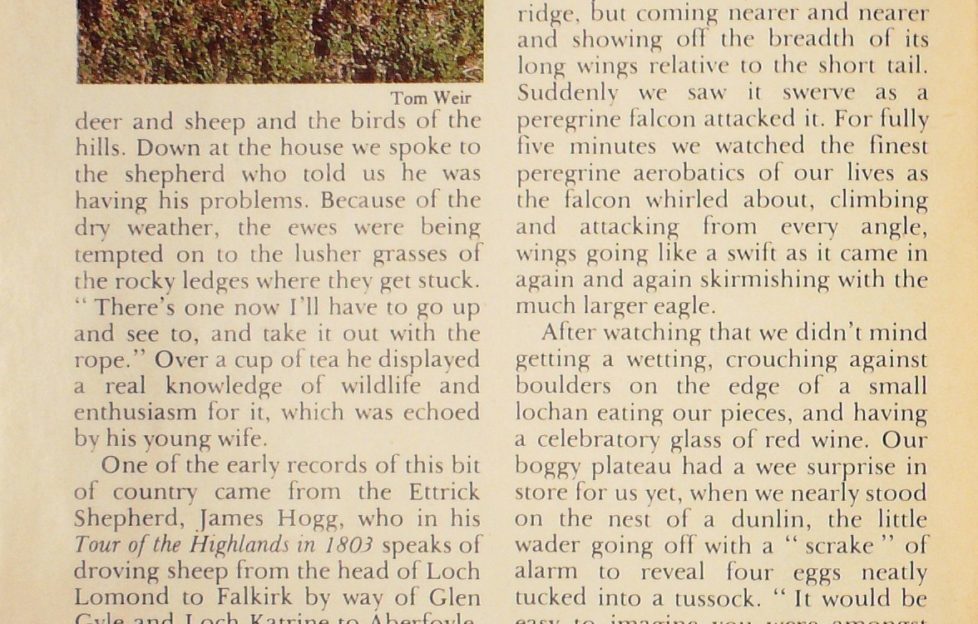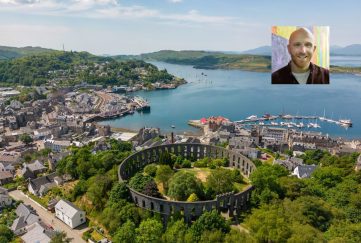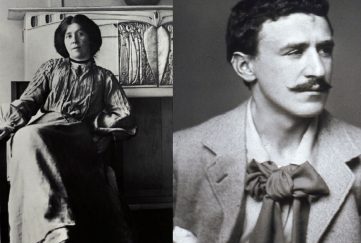Tom Weir | To Wild Places (III)
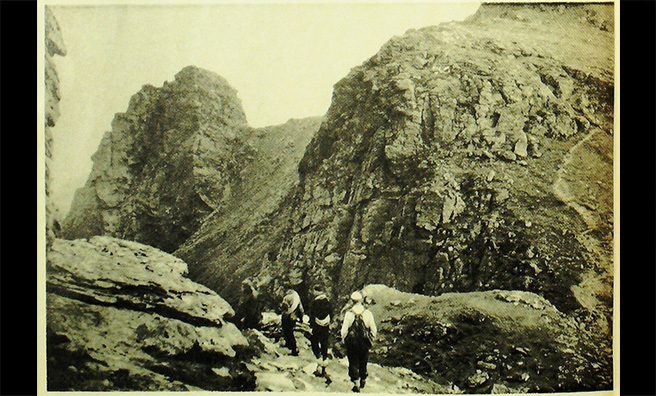
The final instalment of Tom Weir’s column To Wild Places covers a day out in the Trossachs and a battle between the acrobats of the air – a peregrine falcon and a golden eagle
“One early June morning I won’t forget.”
I was at Balfron and I thought I’d take a walk along a stretch of the Endrick where it meanders below the conies of the north side of the Campsies, lovely rolling countryside of big fields and woods.
Under blue skies and towering banks of white cumulus I had never seen it look better than on that day, except that the river was less than half its usual size.
There was plenty to see, however; a family of dancing grey wagtails, the young ones trying to ape the darting flights of their acrobatic parents; a somnolent dipper; two pairs of sandpipers and a family of redshanks.
Then came the thrill of the day, as a kingfisher went whirring past in a flash of sun-brilliant blue- green. To my delight it curved towards a high bank and settled for about two minutes.
No bird plate could have been more artistic than the sight of that beautiful creature, two feet above the water of a crystal pool reflecting the yellow of the flowers on its banks.
3-speed gears
Just nine years ago I bought a couple of folding bicycles for my wife and myself, so that we could use them in the glens on right of way paths where locked gates debar motor cars.
Fitted with 3-speed gears, the bikes have been a splendid success, and we’ve taken them over to Raasay, the Outer Hebrides, and many other places with no more trouble than the occasional puncture.
Now that Pat has one of these bikes, too, he’s become a fervid enthusiast for excursions that combine cycling and hill walking. I had done one trip with him, and now he unfolded the map to show me what our next trip should be.
“We’ll take the bikes to Stronachlachar on Loch Katrine, and cycle the private road round past Glen Gyle. The bikes can be left at the burnside and then we’ll climb the peak due north, Stob an Duibhe. It’s hidden by other peaks, but I’ve looked at the wee bit you can see of it, and it’s got a pinnacle on its ridge.”
He’d said enough, but we hadn’t fixed a date. Came a vivid morning of hail showers following a delightful sunrise of soft gold, and I phoned him before he was properly awake.
“I had a late night,” he apologised, but when I suggested we make the expedition that day he was more than ready.
We met up two hours later at Aberfoyle when the sun was still playing hide and seek with the clouds scudding before the north wind.
It was a joy to leave the car and take to the bike along the shore of Loch Katrine, with frequent stops to look at mergansers, mallard and teal, watch whinchat and redpolls, and enjoy the fringing oaks above the mirror of the loch.
Meall Mor Ridge
Past rocky Glen Gyle, birthplace of Rob Roy, and in another mile we were at the deep cleft of our burn, overhung with natural woodland but with a comfortable ridge on its flank for easy walking.
We struck on to the Meall Mor ridge first where we were in the company of the red deer.
From up there we could watch the hail showers approaching and then rattling us with white pellets before passing on like gauzy curtains dimming the outlines of the Trossachs hills and the distant Campsies.
Luck was with us for we arrived on the top of Stob an Duibhe as all the high hills cleared, from Beinn Chabhair to Stobinian, each peak a different shade of grey or blue.
Now for a go at the wee pinnacle which had excited Pat’s interest.
I took it by its overhanging front and it was good fun, with a raven seeming to bark approval. Immediately below us was the River Lochlarig and by dropping north to it and walking its course eastward for about three miles we could have been at Inverlochlarig, where Rob Roy lived at a later stage- in his life.
Between Loch Katrine and Loch Voil is still a very wild block of country, cut up by innumerable glens and still unspanned by roads.
“That day our only company was deer
and sheep and the birds of the hills.”
Down at the house we spoke to the shepherd who told us he was having his problems. Because of the dry weather, the ewes were being tempted on to the lusher grasses of the rocky ledges where they get stuck.
“There’s one now I’ll have to go up and see to, and take it out with the rope.”
Over a cup of tea he displayed a real knowledge of wildlife and enthusiasm for it, which was echoed by his young wife.
One of the early records of this bit of country came from the Ettrick Shepherd, James Hogg, who in his Tour of the Highlands in 1803 speaks of droving sheep from the head of Loch Lomond to Falkirk by way of Glen Gyle and Loch Katrine to Aberfoyle.
The present hotel of Inverarnan was a droving inn in Hogg’s time and a pass leads from it west to Loch Fyne, with another one just to the north for Glen Shira.
Just three days after our trip Pat and I went off to examine the rather complicated topography of this area, and now we had the company of two ornithological friends.
We were not out to keep to paths, but explore some of the normally very boggy bits peppered with wee lochans, haunts of golden plover, which at 1500 ft. were calling mournfully around us, piping from high knolls and running ahead of us to lead us away from their nesting areas.
An Aerial Attack
It was Pat who spotted his favourite bird, the golden eagle, a mere speck in the sky above a distant ridge, but coming nearer and nearer and showing off the breadth of its long wings relative to the short tail.
Suddenly we saw it swerve as a peregrine falcon attacked it. For fully five minutes we watched the finest peregrine aerobatics of our lives as the falcon whirled about, climbing and attacking from every angle, wings going like a swift as it came in again and again skirmishing with the much larger eagle.
After watching that we didn’t mind getting a wetting, crouching against boulders on the edge of a small lochan eating our pieces, and having a celebratory glass of red wine.
Our boggy plateau had a wee surprise in store for us yet, when we nearly stood on the nest of a dunlin, the little wader going off with a “scrake” of alarm to reveal four eggs neatly tucked into a tussock.
“It would be easy to imagine you were amongst the flows of Sutherland,” I said, casting an eye over the bog cotton moor with its moranic knolls where 10 red deer hinds stood silhouetted.
The time was 3.30 p.m. and two of our party were back in their homes in Glasgow by 5.30 p.m., which illustrates how convenient our greatest city is to some of the best country in Scotland, small scale in the Trossachs but becoming bigger and more spacious with higher tops as you go up Glen Falloch.
Catch the next update from Tom Weir’s archives next Friday, on the filming of Weir’s Way.
More!
Read more from Tom!
We have an extensive archive of Tom Weir’s great columns for The Scots Magazine, and we’re slowly but surely getting them published digitally for new generations to enjoy.
To see the columns we have online so far, click here.


